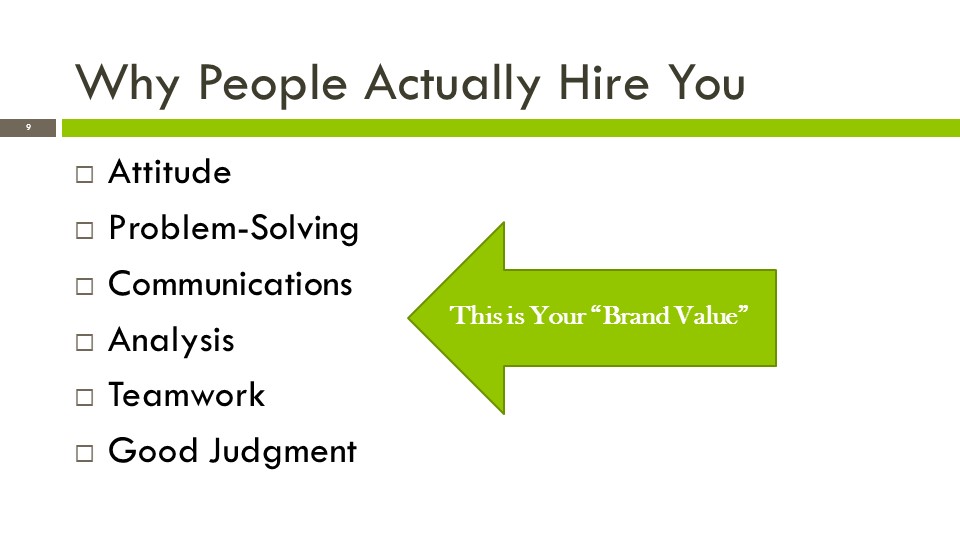The brand word gets thrown around too much. What does it actually mean when you’re a freelancer in creative work? If you’re a photographer, art director, graphic designer, video producer or editor, how do you establish your brand versus that of other folks who use the same tools you do and have similar skills?
Why You Think People Hire You
Most freelancers promote themselves with the skills they think people are looking for. Their websites show software mastered and lists of equipment owned. That’s fine. But this is just the basics. Loads of your competitors have these skills. What clients want to know is what PROBLEMS you can solve for them. So to properly brand and sell yourself, you need to consider what sets you apart.
Why People Actually Hire You
When pitching yourself, describe the personal attributes and abilities that make you a good problem-solver. It might be your positive attitude, your communications skills, your ability to work with challenging personalities, or your ability to lead a team. This is your unique brand value, and that’s what you need to be promoting!
What About My Portfolio?
More and more, prospective clients want me to show them a video that is pretty much like what they want to hire me to produce. This is a tricky problem. I’d love to show them my skills as a director and concept creator for a wide range of productions. But they might not understand how a 5-minute video about a hospital is relevant to their 1-minute opener for a corporate event. So I post custom links to Vimeo–sometimes even password protected–so they can see just the projects that connect to the problem they want to solve. And I sometimes have to generate a set of brief storyboards to convey my concept for their project. More on that in a future post!
For more about branding, follow my tweets @brandbuzz or join me at NABShow where I’ll be speaking about Essential Business Skills for Freelancers at Post/ProductionWorldatNAB.


 There are three kinds of unhappy customers. The ones who let you know about the problem right away. The ones who tell other people they are unhappy, but avoid telling you directly. And the ones who are mostly happy customers and have only one issue they are unhappy about, but this is the only thing they communicate about with you, so it seems like a much larger problem. It’s really important to discern which kind of customer you are dealing with before you can help them. And especially in these days of social media, when a problem that is small can become exponentially larger due to word of mouth.
There are three kinds of unhappy customers. The ones who let you know about the problem right away. The ones who tell other people they are unhappy, but avoid telling you directly. And the ones who are mostly happy customers and have only one issue they are unhappy about, but this is the only thing they communicate about with you, so it seems like a much larger problem. It’s really important to discern which kind of customer you are dealing with before you can help them. And especially in these days of social media, when a problem that is small can become exponentially larger due to word of mouth. t fundraising auctions. Many of the 50+ organizations who signed up indicated that their board members are not fully engaged in outreach events and fundraising. Does this mean they have the wrong board members? Do they need to define roles and expectations? Or do board members actually need some training? I find it’s a bit of each. Whether you are a for-profit or nonprofit, your Board of Directors is a critical component of how you connect to the communities and constituencies you serve. They need to be supporting your brand in multiple ways. How can you help them do this?
t fundraising auctions. Many of the 50+ organizations who signed up indicated that their board members are not fully engaged in outreach events and fundraising. Does this mean they have the wrong board members? Do they need to define roles and expectations? Or do board members actually need some training? I find it’s a bit of each. Whether you are a for-profit or nonprofit, your Board of Directors is a critical component of how you connect to the communities and constituencies you serve. They need to be supporting your brand in multiple ways. How can you help them do this? this one really gets me, for some reason. In our brave new age of social media, increased transparency, and communications efficiency, those little forms that you get when you click “Contact Us” really bug me.
this one really gets me, for some reason. In our brave new age of social media, increased transparency, and communications efficiency, those little forms that you get when you click “Contact Us” really bug me. Edward M. Liddy recently admitted to Congress, “I think the AIG name is so thoroughly wounded and disgraced that we’re probably going to have to change it.” And so begins a re-branding process that starts with re-naming several subsidiary divisions, the way Philip Morris became “Altria.”
Edward M. Liddy recently admitted to Congress, “I think the AIG name is so thoroughly wounded and disgraced that we’re probably going to have to change it.” And so begins a re-branding process that starts with re-naming several subsidiary divisions, the way Philip Morris became “Altria.”


